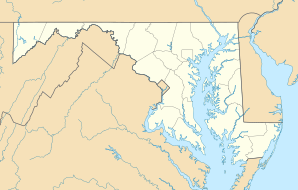Savage (Maryland)
| Savage | ||
|---|---|---|
 The former Savage Mill textile factory |
||
| United States | ||
|
|
||
| Basic data | ||
| Foundation : | 1822 | |
| State : | United States | |
| State : | Maryland | |
| County : | Howard County | |
| Coordinates : | 39 ° 8 ′ N , 76 ° 49 ′ W | |
| Time zone : | Eastern ( UTC − 5 / −4 ) | |
| Residents : | 7,054 (as of 2010) | |
| Population density : | 993.5 inhabitants per km 2 | |
| Area : | 7.12 km 2 (approx. 3 mi 2 ) of which 7.1 km 2 (approx. 3 mi 2 ) is land |
|
| Height : | 64 m | |
| Postal code : | 20763 | |
| Area code : | +1 240, +1 301 | |
| FIPS : | 2470475 | |
| GNIS ID : | 591233 | |
Savage is an unincorporated community in Howard County , Maryland , approximately 12 miles south of Baltimore and 20 miles north of Washington, DC . During the heyday of the textile industry in the 19th century, Savage was an important industrial site , where a textile mill used the hydropower of the slopes of the Little Patuxent River and Middle Patuxent River . In the protected Savage Mill Historic District , the factory buildings that are now used as a shopping center have been preserved.
geography
Savage is close to the town of Laurel and the planned settlement of Columbia . Savage has been a separate CDP since the 2010 census , encompassing the area east of the Little Patuxent River and south of Interstate I-95 , bounded to the east by the industrial railway to Guilford and to the south by Washington Boulevard .
history
The land around Savage was settled around 1650. In 1685 Colonel Henry Ridgely surveyed the area around the future Savage Mill and the Annapolis Junction southeast of it and designated it as Ridgely's Forrest . In 1734 Joseph White started a grain mill on land known as Whites Fortune and Whites Contrivance .
The place was named by John Savage Williams, a businessman from Philadelphia . He lent money to the Williams brothers of Baltimore to build a textile factory near the confluence of the two rivers. The Savage Manufacturing Company was founded in 1820 and acquired 364 acres of land from the White property for $ 6,666.67. The company started production in 1822 and manufactured cotton products, in particular sails for the clippers calling at the port of Baltimore, and later also army uniforms, tents and tarpaulins.
The cotton was brought from the ports of the southern states to Baltimore by ship and from there it was driven overland, first in carts of mules and oxen, to the factory in Savage. In 1835 the Washington branch of the Baltimore and Ohio Railroad was opened, which runs about one and a half kilometers south of the Factory located Savage Station operated. It was not until 1840 that the railway company built an industrial track to the factory, with a stone arch bridge being built to cross the Little Patuxent River . In 1880 the factory was converted to steam operation and the area was redesigned. The arch bridge was therefore replaced in 1887 by a Bollman girder bridge, which was no longer required at another point on the railway network . This Bollman Bridge from 1869 is the only surviving bridge of its type today, although around a hundred such bridges were once in service on the entire Baltimore and Ohio Railroad network. The Bollman Bridge is a Historic Civil Engineering Landmark and is listed on the National Register of Historic Places along with the Savage Mill .
20th century
William Henry Baldwin, Jr ran the factory from 1859 to 1911. Carroll Baldwin Hall was built in 1920 in honor of former factory director Carroll Baldwin. For a long time it housed a branch library of the Howard County Library and is now used for all kinds of events.
In 1937 Savage received a volunteer fire service , the Savage Volunteer Fire Company .
The textile factory ceased operations in 1947. Then Christmas tree decorations were made on the site until this company became insolvent in 1953. The buildings continued to be used as storage space until conversion into a shopping center began in 1882. Today there are shops in five buildings selling handicrafts, antiques and other items. The Savage Mill administration building, Savage Mill Manor House, has been renovated and is used for weddings and other occasions.
Personalities
- Benny Mardones (1946–2020), singer and songwriter who made it into the top 20 of the American charts twice in 1980 and 1989 with the same recording of the same song . Mardones was born in Cleveland and raised in Savage.
- William Bowie (1872–1940), surveyor of Annapolis Junction, who developed the Bowie method , a method to simplify the calculation of large surveying networks.
- Doug Eggers (* 1930), former American football player lives in Savage
- Stephen Warfield Gambrill (1873–1938), Democratic politician and Congressman
Web links
- Savage Mill. Retrieved April 21, 2014 (site of the former factory, now a shopping mall).
- Savage Community Association. Retrieved April 23, 2014 .
Individual evidence
- ↑ Census Block Map: Savage CDP, MD. Census Bureau, accessed April 23, 2014 .
- ^ Joshua Dorsey Warfield: The founders of Anne Arundel and Howard Counties, Maryland , p. 78.
- ^ A b c Savage Community Association: Savage Sites. Retrieved April 23, 2014 .
